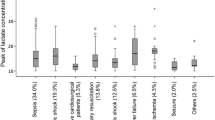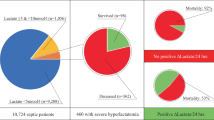Abstract
Hyperlactatemia is a documented complication of diabetic ketoacidosis (DKA). Lactate responses during DKA treatment have not been studied and were the focus of this investigation. Blood gas and electrolyte data from 25 DKA admissions to ICU were sequenced over 24 h from the first Emergency Department sample. Hyperlactatemia (> 2 mmol/L) was present in 22 of 25 DKA presentations [mean concentration = 3.2 mmol/L]. In 18 time-series (72%), all concentrations normalized in ≤ 2.6 h (aggregate decay t1/2 = 2.29 h). In the remaining 7 (28%), hyperlactatemia persisted > 12 h. These were females (P = 0.04) with relative anemia (hemoglobin concentrations 131 v 155 g/L; P = 0.004) and lower nadir glucose concentrations (5.2 v 8.0 mmol/L, P = 0.003). Their aggregate glucose decay curve commenced higher (42 mmol/L v 29 mmol/L), descending towards a lower asymptote (8 mmol/L v 11 mmol/L). Tonicity decay showed similar disparities. There was equivalent resolution of metabolic acidosis and similar lengths of stay in both groups. Hyperlactatemia is common in DKA. Resolution is often rapid, but high lactates can persist. Females with high glucose concentrations corrected aggressively are more at risk. Limiting initial hyperglycemia correction to ≥ 11 mmol/L may benefit.



Similar content being viewed by others
References
Cox K, Cocchi MN, Salciccioli JD, Carney E, Howell M, Donnino MW. Prevalence and significance of lactic acidosis in diabetic ketoacidosis. J Crit Care. 2012;27(2):132–7. https://doi.org/10.1016/j.jcrc.2011.07.071.
Cully M, Thompson AD, DePiero AD. Is lactic acidosis predictive of outcomes in pediatric diabetic ketoacidosis? Am J Emerg Med. 2019. https://doi.org/10.1016/j.ajem.2019.158449.
Gotmaker R, Peake SL, Forbes A, Bellomo R, Investigators* A. Mortality is greater in septic patients with hyperlactatemia than with refractory hypotension. Shock. 2017;48(3):294–300. https://doi.org/10.1097/SHK.0000000000000861.
Bakker J, Gris P, Coffernils M, Kahn RJ, Vincent JL. Serial blood lactate levels can predict the development of multiple organ failure following septic shock. Am J Surg. 1996;171(2):221–6. https://doi.org/10.1016/S0002-9610(97)89552-9.
Masyuk M, Wernly B, Lichtenauer M, Franz M, Kabisch B, Muessig JM, Zimmermann G, Lauten A, Schulze PC, Hoppe UC, Kelm M, Bakker J, Jung C. Prognostic relevance of serum lactate kinetics in critically ill patients. Intensive Care Med. 2019;45(1):55–61. https://doi.org/10.1007/s00134-018-5475-3.
Moskowitz A, Graver A, Giberson T, Berg K, Liu X, Uber A, Gautam S, Donnino MW. The relationship between lactate and thiamine levels in patients with diabetic ketoacidosis. J Crit Care. 2014;29(1):182e185–188. https://doi.org/10.1016/j.jcrc.2013.06.008.
Vincent JL, Quintairos ESA, Couto L Jr, Taccone FS. The value of blood lactate kinetics in critically ill patients: a systematic review. Crit Care. 2016;20(1):257. https://doi.org/10.1186/s13054-016-1403-5.
Morgan TJ, Scott PJ, Anstey CM. Rapid haemodilution accelerates hypertonicity resolution in diabetic ketoacidosis: data from 25 intensive care admissions. Crit Care Resusc. 2019;21(4):274–83.
Hernandez G, Luengo C, Bruhn A, Kattan E, Friedman G, Ospina-Tascon GA, Fuentealba A, Castro R, Regueira T, Romero C, Ince C, Bakker J. When to stop septic shock resuscitation: clues from a dynamic perfusion monitoring. Ann Intensive Care. 2014;4:30. https://doi.org/10.1186/s13613-014-0030-z.
Orringer CE, Eustace JC, Wunsch CD, Gardner LB. Natural history of lactic acidosis after grand-mal seizures. A model for the study of an anion-gap acidosis not associated with hyperkalemia. N Engl J Med. 1977;297(15):796–9. https://doi.org/10.1056/NEJM197710132971502.
Management of diabetic ketoacidosis in adults (age 16 years and over). (2015) Queensland Government. https://www.health.qld.gov.au/__data/assets/pdf_file/0028/438391/diabetic-ketoacidosis.pdf. Accessed 5 May 2019
Feenstra RA, Kiewiet MK, Boerma EC, ter Avest E. Lactic acidosis in diabetic ketoacidosis. BMJ Case Rep. 2014. https://doi.org/10.1136/bcr-2014-203594.
Mehta RL, Kellum JA, Shah SV, Molitoris BA, Ronco C, Warnock DG, Levin A. Acute kidney injury network: report of an initiative to improve outcomes in acute kidney injury. Crit Care. 2007;11(2):R31.
Ratner RE. Hypoglycemia: new definitions and regulatory implications. Diab Technol Ther. 2018;20(S2):S250–S253253. https://doi.org/10.1089/dia.2018.0113.
Siggaard-Andersen O, Fogh-Andersen N. Base excess or buffer base (strong ion difference) as measure of a non-respiratory acid-base disturbance. Acta Anaesthesiol Scand Suppl. 1995;107:123–8.
Bhagat CI, Garcia-Webb P, Fletcher E, Beilby JP. Calculated vs measured plasma osmolalities revisited. Clin Chem. 1984;30(10):1703–5.
Bagshaw SM, Townsend DR, McDermid RC. Disorders of sodium and water balance in hospitalized patients. Can J Anaesth. 2009;56(2):151–67. https://doi.org/10.1007/s12630-008-9017-2.
Kitabchi A, Hirsch, IB, Emmett, M (2015) Diabetic ketoacidosis and hyperosmolar hyperglycemic state in adults: clinical features, evaluation and diagnosis. UpToDate. Accessed 20 Jan 2016
Kitabchi AE, Umpierrez GE, Miles JM, Fisher JN. Hyperglycemic crises in adult patients with diabetes. Diab Care. 2009;32(7):1335–433. https://doi.org/10.2337/dc09-9032.
Knaus WA, Draper EA, Wagner DP, Zimmerman JE. APACHE II: a severity of disease classification system. Crit Care Med. 1985;13(10):818–29.
Knaus WA, Wagner DP, Draper EA, Zimmerman JE, Bergner M, Bastos PG, Sirio CA, Murphy DJ, Lotring T, Damiano A, et al. The APACHE III prognostic system. Risk prediction of hospital mortality for critically ill hospitalized adults. Chest. 1991;100(6):1619–36.
Paul E, Bailey M, Kasza J, Pilcher D. The ANZROD model: better benchmarking of ICU outcomes and detection of outliers. Crit Care Resusc. 2016;18(1):25–36.
Paul E, Bailey M, Pilcher D. Risk prediction of hospital mortality for adult patients admitted to Australian and New Zealand intensive care units: development and validation of the Australian and New Zealand Risk of Death model. J Crit Care. 2013;28(6):935–41. https://doi.org/10.1016/j.jcrc.2013.07.058.
Bolli G, Cartechini MG, Compagnucci P, Massi-Benedetti M, Filipponi P, Nicoletti I, De Feo P, Angeletti G. Adrenergic activity and glycometabolic compensation in patients with diabetes mellitus. Minerva Med. 1979;70(55):3783–95.
Morgan TJ, Venkatesh B, Bellomo R. Acid-base physiology: comments on 10 contentious assertions. Crit Care Resusc. 2015;17(3):211–3.
Levy B, Gibot S, Franck P, Cravoisy A, Bollaert PE. Relation between muscle Na+K+ ATPase activity and raised lactate concentrations in septic shock: a prospective study. Lancet. 2005;365(9462):871–5. https://doi.org/10.1016/S0140-6736(05)71045-X.
Garcia-Alvarez M, Marik P, Bellomo R. Stress hyperlactataemia: present understanding and controversy. Lancet Diab Endocrinol. 2014;2(4):339–47. https://doi.org/10.1016/S2213-8587(13)70154-2.
Owen OE, Kalhan SC, Hanson RW. The key role of anaplerosis and cataplerosis for citric acid cycle function. J Biol Chem. 2002;277(34):30409–122. https://doi.org/10.1074/jbc.R200006200.
Bender DA, Mayes PA. Overview of metabolism & the provision of metabolic fuels. In: Rodwell VW, Bender DA, Botham KM, Kennelly PJ, Weil PA, editors. Harper's Illustrated Biochemistry. New York: McGraw-Hill Education; 2018.
Botham KM, Mayes PA. Biosynthesis of fatty acids & eicosanoids. In: Rodwell VW, Bender DA, Botham KM, Kennelly PJ, Weil PA, editors. Harper's Illustrated Biochemistry. New York: McGraw-Hill Education; 2018.
Siess EA, Wieland OH. Regulation of pyruvate dehydrogenase interconversion in isolated hepatocytes by the mitochondrial ATP/ADP ratio. FEBS Lett. 1975;52(2):226–30. https://doi.org/10.1016/0014-5793(75)80811-8.
van Berlo-van de Laar IR, Vermeij CG, Doorenbos CJ. Metformin associated lactic acidosis: incidence and clinical correlation with metformin serum concentration measurements. J Clin Pharm Ther. 2011;36(3):376–82. https://doi.org/10.1111/j.1365-2710.2010.01192.x.
Campbell CH. The severe lacticacidosis of thiamine deficiency: acute pernicious or fulminating beriberi. Lancet. 1984;2(8400):446–9. https://doi.org/10.1016/s0140-6736(84)92918-0.
Collie JTB, Greaves RF, Jones OAH, Lam Q, Eastwood GM, Bellomo R. Vitamin B1 in critically ill patients: needs and challenges. Clin Chem Lab Med. 2017;55(11):1652–68. https://doi.org/10.1515/cclm-2017-0054.
Rosner EA, Strezlecki KD, Clark JA, Lieh-Lai M. Low thiamine levels in children with type 1 diabetes and diabetic ketoacidosis: a pilot study. Pediatr Crit Care Med. 2015;16(2):114–8. https://doi.org/10.1097/PCC.0000000000000302.
Matz R. Parallels between treated uncontrolled diabetes and the refeeding syndrome with emphasis on fluid and electrolyte abnormalities. Diab Care. 1994;17(10):1209–13. https://doi.org/10.2337/diacare.17.10.1209.
Hanlan ME, Griffith J, Patel N, Jaser SS. Eating disorders and disordered eating in type 1 diabetes: prevalence, screening, and treatment options. Curr Diab Rep. 2013. https://doi.org/10.1007/s11892-013-0418-4.
Toni G, Berioli MG, Cerquiglini L, Ceccarini G, Grohmann U, Principi N, Esposito S. Eating disorders and disordered eating symptoms in adolescents with type 1 diabetes. Nutrients. 2017. https://doi.org/10.3390/nu9080906.
Murphy WG. The sex difference in haemoglobin levels in adults—mechanisms, causes, and consequences. Blood Rev. 2014;28(2):41–7. https://doi.org/10.1016/j.blre.2013.12.003.
Faigel DO, Metz DC. Prevalence, etiology, and prognostic significance of upper gastrointestinal hemorrhage in diabetic ketoacidosis. Dig Dis Sci. 1996;41(1):1–8.
Martensson J, Bailey M, Venkatesh B, Pilcher D, Deane A, Abdelhamid YA, Crisman M, Verma B, MacIsaac C, Wigmore G, Shehabi Y, Suzuki T, French C, Orford N, Kakho N, Prins J, Ekinci EI, Bellomo R. Intensity of early correction of hyperglycaemia and outcome of critically ill patients with diabetic ketoacidosis. Crit Care Resusc. 2017;19(3):266–73.
Diabetic ketoacidosis care pathway 1 NHS Scotland. https://www.diabetesinscotland.org.uk/Publications/DKA%20Care%20Pathway%201%20v10.pdf. Accessed 12 Dec 2019
Rhodes A, Evans LE, Alhazzani W, Levy MM, Antonelli M, Ferrer R, Kumar A, Sevransky JE, Sprung CL, Nunnally ME, Rochwerg B, Rubenfeld GD, Angus DC, Annane D, Beale RJ, Bellinghan GJ, Bernard GR, Chiche JD, Coopersmith C, De Backer DP, French CJ, Fujishima S, Gerlach H, Hidalgo JL, Hollenberg SM, Jones AE, Karnad DR, Kleinpell RM, Koh Y, Lisboa TC, Machado FR, Marini JJ, Marshall JC, Mazuski JE, McIntyre LA, McLean AS, Mehta S, Moreno RP, Myburgh J, Navalesi P, Nishida O, Osborn TM, Perner A, Plunkett CM, Ranieri M, Schorr CA, Seckel MA, Seymour CW, Shieh L, Shukri KA, Simpson SQ, Singer M, Thompson BT, Townsend SR, Van der Poll T, Vincent JL, Wiersinga WJ, Zimmerman JL, Dellinger RP. Surviving sepsis campaign: international guidelines for management of sepsis and septic shock: 2016. Intensive Care Med. 2017;43(3):304–77. https://doi.org/10.1007/s00134-017-4683-6.
Funding
Project supported by Departmental Funds.
Author information
Authors and Affiliations
Corresponding author
Ethics declarations
Conflict of interest
The authors declare that they have no competing interests.
Ethical approval
This research was performed in accordance with the requirements of the National Statement on Ethical Conduct in Human Research (2007). The need for individual patient consent was waived by the Human Research Ethics Committee, Mater Research (HREC/18/MHS/22).
Additional information
Publisher's Note
Springer Nature remains neutral with regard to jurisdictional claims in published maps and institutional affiliations.
Electronic supplementary material
Below is the link to the electronic supplementary material.
Rights and permissions
About this article
Cite this article
Morgan, T.J., Scott, P.H., Anstey, C.M. et al. Hyperlactatemia in diabetic ketoacidosis is common and can be prolonged: lactate time-series from 25 intensive care admissions. J Clin Monit Comput 35, 757–764 (2021). https://doi.org/10.1007/s10877-020-00532-9
Received:
Accepted:
Published:
Issue Date:
DOI: https://doi.org/10.1007/s10877-020-00532-9




